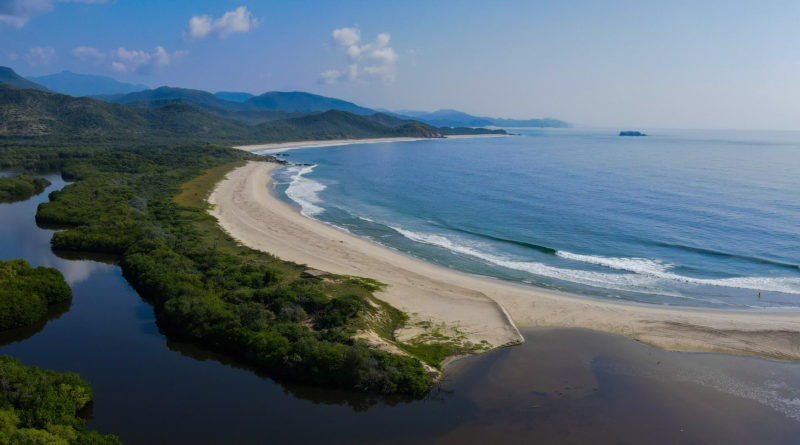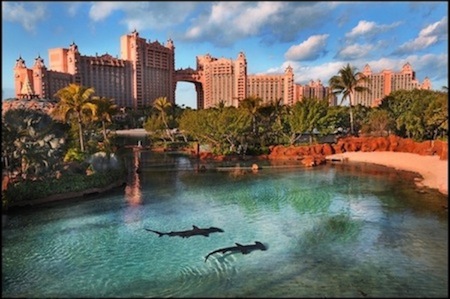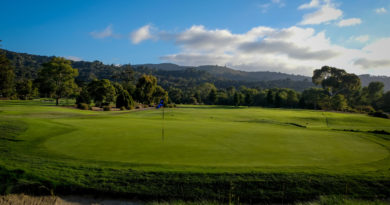Huatulco’s Imprint in the Sand : THE WILD COAST OF OAXACA
By Marlise Kast-Myers | Photos by Benjamin Myers
Growing up as the daughter of missionaries, my childhood travels were usually centered around giving back. From South Africa and Hong Kong to Romania and Tanzania, each purposeful journey involved some level of digging ditches, feeding children, raising awareness, and rescuing the lost.
By the time I graduated from college, I went rogue, traveling for the sake of my own benefit, longing for experiences that would seep into my pores for mental stimulation rather than philanthropic impact. Adventure, freedom, culture — nearly every box was checked in my otherwise home-bound soul.
That is, until Huatulco.
Located in the Mexican state of Oaxaca, the fishing village is home to nine bays, 36 beaches, and thousands of baby turtles that apparently needed me (or was it the other way around?). Whatever the case, I had three open days on my calendar, and a desire to surf some waves and save some turtles. And so, away I went to Huatulco.
A friend of a friend had looped me into a group of champions-for-change who were protecting coastal and marine ecosystems in the U.S. and Mexico. Based out of San Diego, this powerhouse of protectors called themselves WILDCOAST, and low and behold, they were heading to Huatulco.
Small but mighty, they acted out a David and Goliath storyline back in 2001, taking on corporate giants to shut down a Baja factory that would wipe out a breeding ground for whales. That first environmental success story was the spark igniting an army of advocates that today conserve over 38 million acres of protected areas in Oaxaca, Baja, and beyond.
Needless to say, they have a lot of ground to cover, which is where researchers, fishermen, environmentalists, politicians —and even volunteers like me—come in. The Mexican state of Oaxaca had always been on my bucket list. For years, my husband shared tales of the vibrant city by the same name, known as the state’s cultural, historic, artistic, and agricultural hub.
Home to rivers, waterfalls, and beaches, Huatulco wasn’t far from Puerto Escondido, boasting massive waves surfed by legendary big-wave riders. On this trip however, it was about saving turtles on a desolate beach far from tourist attractions.
But first, I wanted to sleep. A painful 5 AM arrival to Cross Border Xpress (CBX) meant that I could park in San Diego and walk across the pedestrian bridge into Tijuana’s international airport. Flights to Mexico are generally more affordable and direct when using CBX, but in this case, it meant an unearthly wake-up call.
On the bright side, I was at my hotel by 3 PM, checking into Camino Real Zaashila Huatulco, with its sugar-cube-like buildings stacked around Tangolunda Bay. Built by Mexican architect, Javier Sordo Madaleno, the property had all the creature comforts including a pool longer than a football field.
After a swim and a nap, I dined at the water’s edge, sampling local dishes like empanadas with mole, chapulines (deep-fried grasshoppers), and tlayudas— crunchy tortillas layered with beans, meat, cabbage, avocado, and Oaxaca cheese.
Early to bed, early to rise, I hitched a boat to Huatulco National Park where the WILDCOAST crew was out inspecting buoys. They had recently installed the system to prevent boats from dropping anchor on coral reefs.
The 29,000-acre national park has been designated a whale-watching zone and UNESCO Biosphere Reserve. As our boat cut through water, olive-ridley turtles bobbed at the surface and manta rays leapt toward the sky, smacking their wings like a bellyflop gone right. From Chachacual beach, I snorkeled among angel fish, trumpet fish, and even a zebra moray that looked like a snake on a mission.
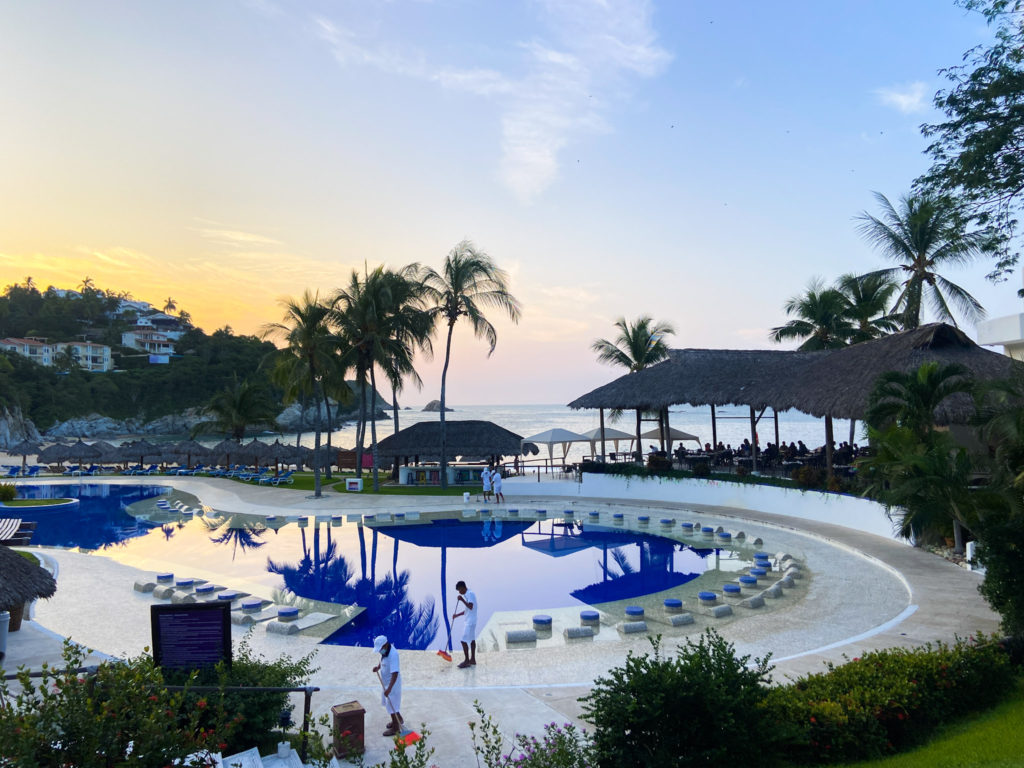
The nearby cove of Playa La India was the ideal spot for round two, where I snorkeled (yet again) above Yellowtail Sturgeon fish getting a scrub down by pecking rainbow wrasses. Back onboard, the salt air sprayed my sun-kissed face as I counted barren bays in our wake. With arms folded, I rested my chin on the edge of the boat, lost somewhere between the white noise of wind and waves.
At dreamy Cacaluta Bay, locals prepared a toes-in-the-sand Oaxacan picnic of ceviche, grilled fish, and tlayudas, with a line of salsas to dribble on each bite. Had my trip ended there, I would have been perfectly content. But with just 48 hours still left on the clock, I was determined to make the most of my time in Huatulco.
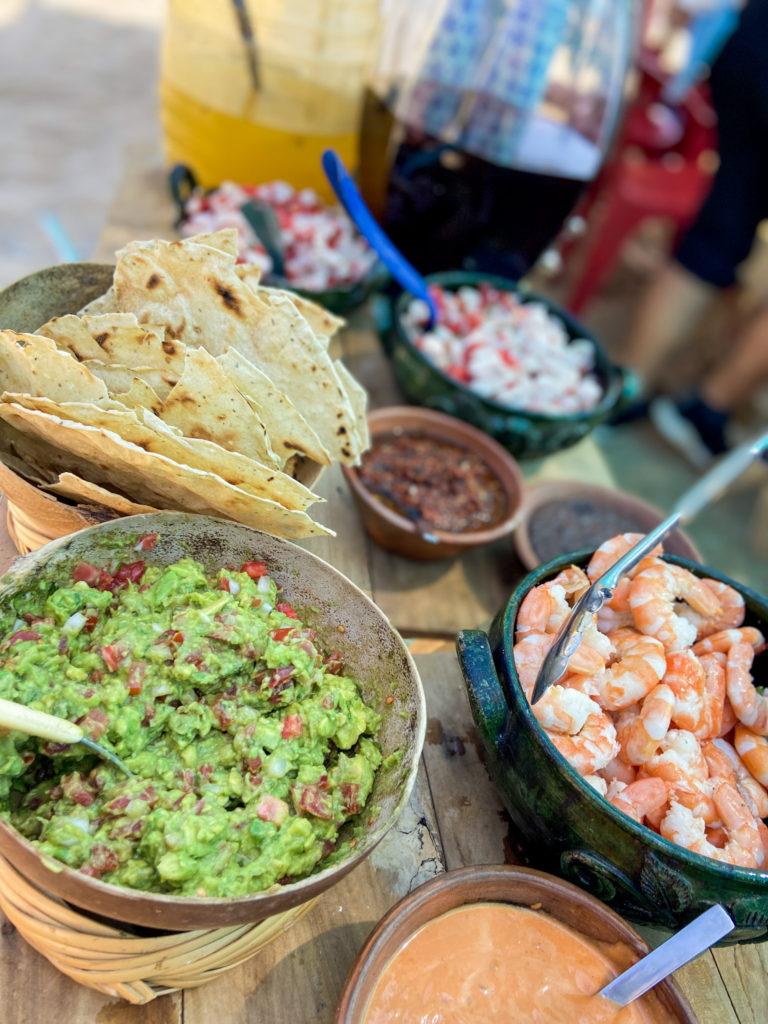
By late afternoon, I was on the banks of the Copalita River with local outfitter, Rancho Tangolunda. The drive to the launching point was as much as an adventure as the rafting itself. Loading onto a cattle car, I bounced through papaya plantations and pocket-size pueblos where man was absent but butterflies abundant, fluttering between jungle vines and trumpet flowers. Considered one of Mexico’s best white-water rafting rivers, the rapids spilled from the Sierra Madre Mountains into the Pacific Ocean.
As a novice rafter, I paddled my heart out along the bubbly Class 2 section, getting tossed around in my inflatable raft like a kid on a trampoline. Dwarfed by the mighty tropical forest, the mountains nibbled the sun, leaving just enough light to grab tacos in the town of La Crucecita.
Located 10 minutes from my hotel, this sleepy center has a handful of restaurants, shops, and noteworthy attractions including the colonial-style chapel of Parroquia de Nuestra Señora de Guadalupe.
Unlike adventures in my 20’s, this whirlwind trip had me in bed by 9 PM and awake by 5 AM. I was on a mission to save some turtles.
The early wakeup call took me to La Escobilla to experience WILDCOAST in action. Just one hour north of Huatulco, this protected beach is where arribada—mass turtle nesting— happens. Translated to “arrival by sea,” the natural phenomenon occurs at 12 beaches around the world, three of which are in Mexico. Lasting just four days during rainy season, literally hundreds of thousands of female sea turtles shimmy their way ashore to lay their eggs.
Between threats of poachers, dogs, vultures, crabs, beetles, development, and oil spills, the hatchlings have the whole world against them. As recently as 2002, turtle poaching was not only a common practice, but an important part of the culture and diet in the Oaxacan communities.
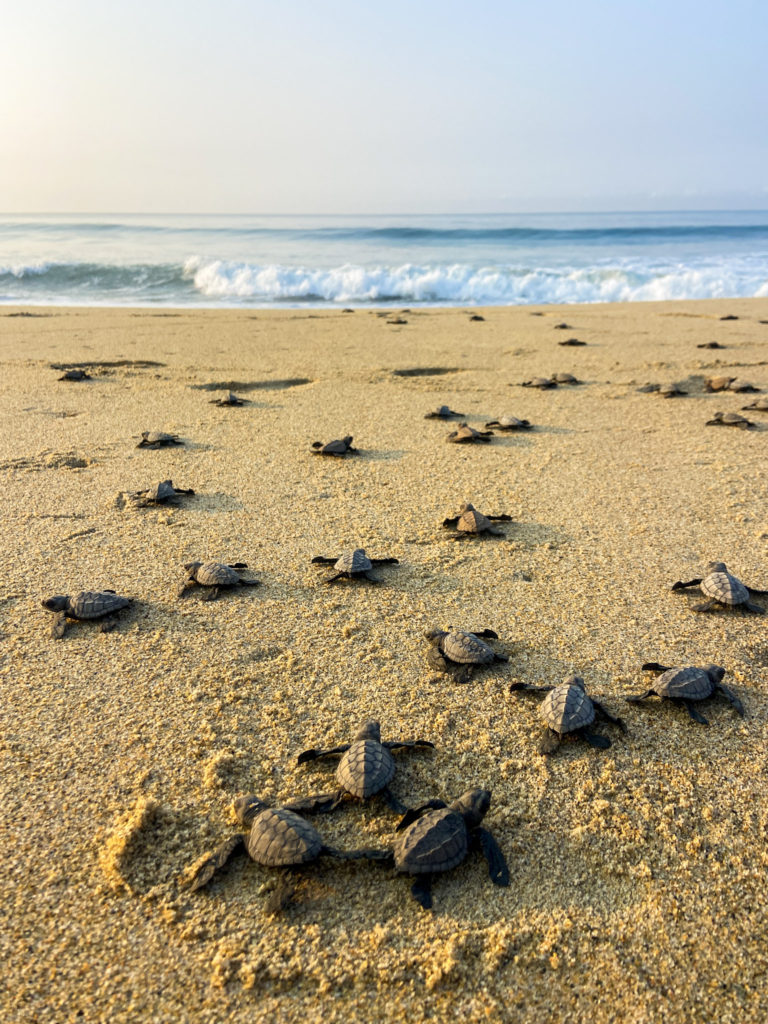
Enter WILDCOAST, stage right, which monitors the two Oaxacan arribada beaches of Escobilla and Morro Ayuta, spanning 22 miles of critical turtle nesting beaches. Their conservation quest unfolded in the heart of the nonprofit’s Executive Director, Serge Dedina. In 2002, Serge launched a major campaign to halt the illegal trade of turtle eggs and meat.
In partnership with La Escobilla Beach Sanctuary, the Mexican Turtle Center, and CONANP (National Commission of Protected Areas), WILDCOAST now rescues turtle eggs and recreates habitats by monitoring temperatures and humidity.
Thanks to their efforts, the olive ridley and eastern Pacific green sea turtles have made a major comeback, with now over 72 million turtles being born on the beaches that WILDCOAST protects.
Fortunately, I got to hold 50 of the tiny hatchlings in a Tupperware bowl. No larger than the palm of my hand were these little hockey pucks with legs, ready to take on the world. Each one had hope, stretching their micro-dinosaur heads toward the light, and paddling with all their might within my plastic container.
Pushing the bambinos away from the bowl’s rim, I caught eyes with Don Eradio, who smiled at my joy. As a former turtle egg poacher, he now dedicates his life to conserving turtles and protecting local beaches where 80% of the world’s ridley turtle population comes to nest.
Despite an average laying clutch of 100 eggs, just one in 1,000 baby turtles will make it to adulthood. Between predators and dehydration, the survival rate from nest to sea is slim.
Gazing into the bowl, I so badly wanted them to taste the sea and find refuge somewhere deep in the belly of the ocean. Finally, it was time to liberate those little nuggets and set them free. But there was one condition: they couldn’t be touched.
Ironically, the struggle is part of their survival journey. Each one leaves an imprint on the sand where they were hatched, hopefully to someday return to nest on that same beach. Not only does human touch interfere with their imprinting process, but the physical pressure could potentially puncture their food sac carrying three-day’s worth of food.
As I slowly tipped the bowl, out spilled my mob of hatchlings, some moving full steam ahead while others barely paddled in place. Several crawled in the wrong direction, eventually spinning in circles until they could feel the wet sand beneath their flippers. Literally hundreds of them began to spread out, sprawling across the beach like little polka dots on a blanket. Each one clung to the cues of water—from the spray on their shells to the wetness on their claws.
With each set of waves, we witnessed survival of the fittest, some pushing past the whitewash while others crashed back to shore. Their fight for life—and their draw toward the light—made me want to cry. No one spoke. Everyone watched.
Behind us was a flock of birds ready to dive into the sea for their moving targets. Miniature volcanos erupted from the sand, revealing hungry crabs scuttling toward the fragile turtle tribe.
“One in 1,000,” I kept thinking. Nature was cruel and compassionate at the same time. After 30 long minutes, the last hatchling made his way to the sea, causing our group of turtle advocates to erupt in spontaneous cheer.
Over breakfast at Lodeli, I thought about that life-giving moment, and wondered how many of my turtles had in fact survived. The bohemian café was packed, located in the nearby hippie town of Mazunte where yoga and dreadlocks prevail. That afternoon, I surfed nearly three hours at Barra de la Cruz, and yet again the following morning before my flight. The indigenous Chontal village east of Huatulco had a right-hand point break that made me want to extend my trip. Had I known all that Huatulco had to offer, I would have planned for spontaneity and turtle bonding. Instead, I talked about what was next with WILDCOAST, a group of pioneers-turned-friends.
That last night, we dined together at Clio’s in Huatulco, discussing efforts to save whales and impact communities. Between the restaurant’s French culinary techniques and Mesoamerican roots, I was in awe of the cuisine but somehow lost in my thoughts.
Gazing around the table, I could almost feel their heart for conservation—once top executives who had left the corporate world to help build a better one with WILDCOAST. They put mission into action and believed in the “one” regardless of what statistics told them.
Raising my glass, I toasted to the “one” hatchling that would someday return to Escobilla beach, overcoming struggles to manifest survival.
Now well into my 40’s, perhaps I wouldn’t abandon my heart for “the lost” after all, and would instead, return to my roots to leave an imprint in the sand.
Marlise Kast-Myers as is an award winning travel writer

